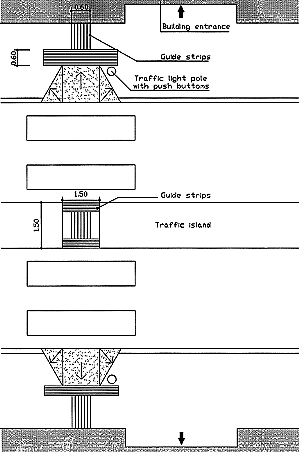1. PROBLEM IDENTIFICATION
Uneven road surface.
Lack of guide strips.
Lack of warning marking for crossings.
Gratings on the road surface.
2. PLANNING PRINCIPLE
To facilitate the safe and independent crossing of disabled people.
3. DESIGN CONSIDERATIONS
3.1 General
 Pedestrian crossings should be equipped with
traffic control signals. Pedestrian crossings should be equipped with
traffic control signals.
 Low-traffic crossings frequently used by
disabled people can be controlled by a pedestrian push-button system. Low-traffic crossings frequently used by
disabled people can be controlled by a pedestrian push-button system.
 Constructing traffic islands to reduce the
length of the crossing is recommended for the safety of all road users. Constructing traffic islands to reduce the
length of the crossing is recommended for the safety of all road users.
3.2 Guide strips (fig. 1)
 Guide strips should be constructed to
indicate the position of pedestrian crossings for the benefit of sightless pedestrians
(see Pathways; Curb Ramps). Guide strips should be constructed to
indicate the position of pedestrian crossings for the benefit of sightless pedestrians
(see Pathways; Curb Ramps).
 A guide strip should lead to pedestrian light
poles with push buttons for the benefit of the visually disabled. A guide strip should lead to pedestrian light
poles with push buttons for the benefit of the visually disabled.
3.3 Traffic signals
 Pedestrian traffic lights should be provided
with clearly audible signals for the benefit of sightless pedestrians. Pedestrian traffic lights should be provided
with clearly audible signals for the benefit of sightless pedestrians.
 Acoustic devices (1)
should be installed on a pole at the point of origin of crossing and not at the point of
destination. Acoustic devices (1)
should be installed on a pole at the point of origin of crossing and not at the point of
destination.
 The installation of two adjacent acoustic
devices such as bleepers is not recommended in order to avoid disorientation. The installation of two adjacent acoustic
devices such as bleepers is not recommended in order to avoid disorientation.
 The time interval allowed for crossing should
be programmed according to the slowest crossing persons. The time interval allowed for crossing should
be programmed according to the slowest crossing persons.
3.4 Push buttons
 Push buttons should be easy to locate and
operate and should be placed between 0.90 m and 1.20 m off the ground for the benefit of
wheelchair users. Push buttons should be easy to locate and
operate and should be placed between 0.90 m and 1.20 m off the ground for the benefit of
wheelchair users.
3.5 Traffic islands
 The traffic island depth should not be less
than 1.50 m. The traffic island depth should not be less
than 1.50 m.
 The width of a traffic island should not be
less than 1.50 m. The width of a traffic island should not be
less than 1.50 m.
 A coloured tactile marking strip at least
0.60 m wide should mark the beginning and the end of a traffic island, to guide
pedestrians with impaired vision to its location. A coloured tactile marking strip at least
0.60 m wide should mark the beginning and the end of a traffic island, to guide
pedestrians with impaired vision to its location.
3.6 Road hump
 The road surface at pedestrian crossings can
be raised to the same level as the pathway so that wheelchair users do not have to
overcome differences in height (2) (fig. 2). The road surface at pedestrian crossings can
be raised to the same level as the pathway so that wheelchair users do not have to
overcome differences in height (2) (fig. 2).
3.7 Surface
 The road surface should be firm,
well-drained, non-slip and free of construction joints. The road surface should be firm,
well-drained, non-slip and free of construction joints.
3.8 Drains and gratings (see Pathways)
4. EXISTING CONTRUCTIONS
 The road surface should be firm,
well-drained, non-slip and free of construction joints. The road surface should be firm,
well-drained, non-slip and free of construction joints.
Notes:
(1) Experience shows that acoustical signals encourage safer crossing behavior among
children as well
(2) Road bumps are also helpful in reducing the speed of traffic approaching the
intersection. |




